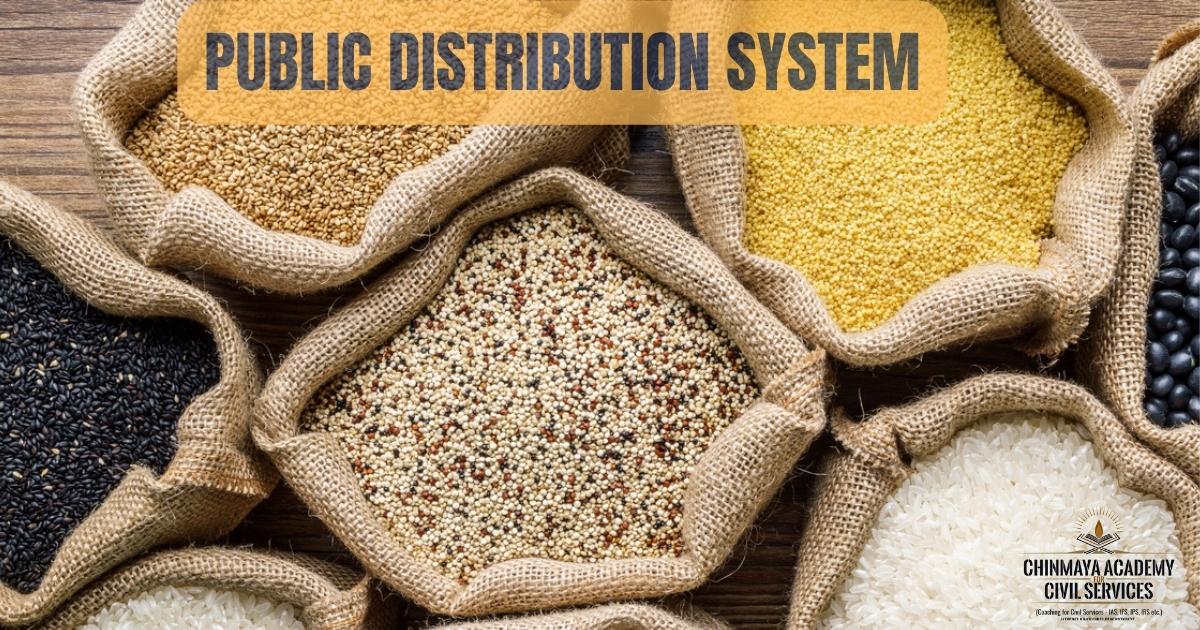The Public Distribution System (PDS) evolved as a system of management of scarcity through the distribution of food grains at affordable prices.
It operates under the joint responsibility of the Central and the State/UT Governments:
Responsibilities of Central government
- Procurement, storage, transportation and bulk allocation of food grains to the State Governments
- Achieved through the Food Corporation of India (FCI)
Responsibilities of state government
- allocation within State
- identification of eligible families
- issue of Ration Cards
- supervision of Fair Price Shops (FPSs)
Targeted Public Distribution System (TPDS)
- Launched in June, 1997
- States were required to identify the poor for the smooth function of Fair Price Shops in a transparent and accountable manner.
- Under the TPDS, the end retail price was fixed by the States/UTs after taking into account margin for wholesalers/ retailers, transportation charges, levies local taxes etc.
Antyodaya Anna Yojana (AAY)
- Aims at reducing hunger among the poorest segments of the BPL population.
- It was launched in December, 2000 for one crore poorest of the poor families who couldn’t afford two square meals a day.
- AAY involved identification of one crore poorest of the poor families from amongst the number of BPL families covered under TPDS within the States and providing them food grains at a highly subsidized rate of Rs.2/- per kg. for wheat and Rs.3/- per kg for rice.
- The AAY Scheme has since expanded through three phases to cover 2.50 crore poorest of the poor household.
National Food Security Act, (NFSA) 2013
The enactment of this act marks a paradigm shift in the approach to food security from welfare to rights-based approach.
It legally entitles up to 75% of the rural population and 50% of the urban population to receive subsidized foodgrains under TPDS.
Further, it aids women empowerment as the eldest woman of the household of age 18 years or above is mandated to be the head of the household for the purpose of issuing of ration cards under the Act.
The act utilizes life-cycle approach to provide special provisions for pregnant women, lactating mothers and children, such as:
- Provision for nutritious meal free of cost through Anganwadi Centres under ICDS scheme for pregnant women, lactating mothers and children below six years
- Children in the age group of 6 to 14 years receive one hot cooked meal through PM Poshan scheme
- Pregnant women and lactating mothers are further entitled to receive cash maternity benefit of not less than Rs. 6,000 to partly compensate for the wage loss during the period of pregnancy and also to supplement nutrition.
DIRECT BENEFIT TRANSFER (DBT)
Under this scheme, cash is transferred to the beneficiaries’ account instead of the foodgrains subsidy component.
Aims to
- reduce the need for huge physical movement of foodgrains
- provide greater autonomy to beneficiaries to choose their consumption basket
- enhance dietary diversity
- reduce leakages
- facilitate better targeting
- promote financial inclusion
Issues with Public Distribution System
- Difficulty in identifying BPL population due to lack of standard methodology. This leads to inclusion and exclusion error in the data.
- It is found to be less efficient in the rural regions in terms of timely and sufficient availability of food grains.
- Reduction in viability of PDS as the cost of food subsidies and procurement costs has increased significantly over the years.
- Procurement by FCI has reduced the net quantity accessible on the open market resulting price hikes for food items.
- Pervasiveness of corruption, losses from transportation and diversion along with ghost beneficiaries cause heavy leakages.
Few reforms undertaken
- End-to-end Computerization of PDS
- To improve the efficiency and transparency of the food grain distribution system
- Employs the use of GPS and SMS technology to arrest leakages and diversions
- Integrated Management of Public Distribution System (IM-PDS)
- Also known as the ‘One Nation One Ration Card Plan’
- It allows beneficiaries to obtain their entitled foodgrains from any Fair Price Shop (FPS) in the country by using their existing ration card
- Integration of the PDS and the Aadhaar system
- Addresses the issue of ghost beneficiaries
- Easier to locate legitimate beneficiaries and guarantee proper distribution
Other NEWS:
| Delhi Motor Vehicle Aggregator and Delivery Service Provider Scheme-2023 |
|
| hydel power |
|
| ‘India’s share of growth to rise to 18%’ |
|
 Chinmaya IAS Academy – Current Affairs Chinmaya IAS Academy – Current Affairs
Chinmaya IAS Academy – Current Affairs Chinmaya IAS Academy – Current Affairs

